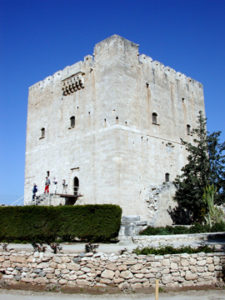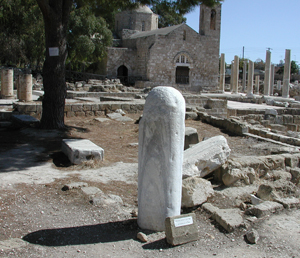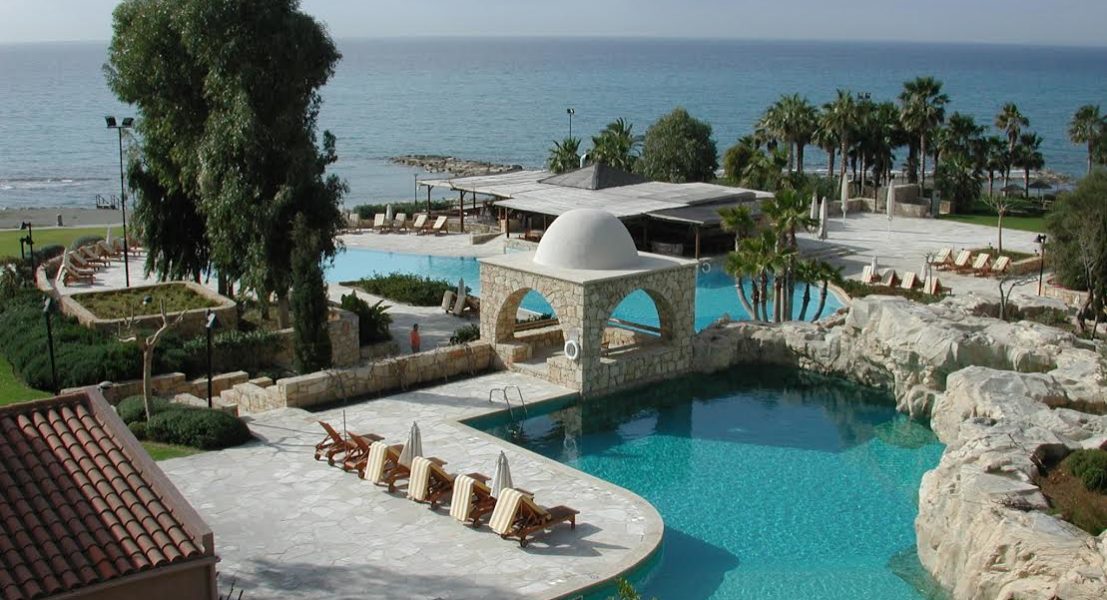By David DeVoss
After being forced to flee the chaos of Lebanon to the island of Cyprus late last month, an American woman on her first vacation to the Mediterranean was asked what she thought about her involuntary place of refuge. “I think Cyprus is heaven,” she said unequivocally. “I should have come here in the first place.”
For more than three millennia Hellenic wanderers, Egyptian Ptolemies, Crusading Knights and Ottoman Kings have regarded Cyprus as both paradise and playground.

Front doors usually are open in Cypriot villages
Yet when it comes to travel Cyprus often gets overlooked, which is a shame since this small (3,570 sq. mile), ethnically diverse (77% Greek Cypriot; 18% Turkish Cypriot) republic in the eastern Mediterranean offers a wealth of Roman history, some of the Europe’s best wine, a variety of scenic mountain villages and a surprising number of luxury beach resorts.
Cyprus is where Greek mythology says Aphrodite, the goddess of love and beauty, rose from the sea in a fountain of spume and in the hills above Pafos (pop. 50,000), the island’s Hellenistic capital from 300 to 100 BC, you can visit a spring-fed pool where guides swear the Goddess liked to bathe.
Cyprus’ real history is far more interesting than its mythology. Just west of Limassol on a hill overlooking the ocean sits the settlement of Kourion. Founded by Peloponnesian Greeks from Argos, the city was destroyed by earthquakes in the 4th century AD, and then rebuilt only to be sacked by Arabs 300 years later. Today Kourion is an active archaeology site that features a 5th century Roman basilica, a majestic Sanctuary of Apollo and an open air Greek theater used for Shakespeare plays in the summer. The most remarkable structure, however, is the House of Eustolios, a 30-room bathing complex – the cold water plunge pool was called the frigidarium – built in the 4th century AD that has porticos paved with mosaic renditions of animals.

Kolossi Castle
I came to Cyprus to do research on the Crusades, the two centuries long religious conflict that finally ended in 1291 with the collapse of the fortified city of Acre in modern day Israel. Expelled from the Holy Land, the Knights of St. John , also knows as the Hospitallers, made their way to Cyprus, a Christian island controlled by the Lusignan kings of France. There they set up shop in Kolossi Castle, built a 40 miles aqueduct to bring water from the mountains and began making St. John Commandaria, a fortified port-like wine that is the oldest wine trademark in the world.
Crusader castles on Cyprus are not as large or elaborate as those in Israel, Jordan and Syria, but the castles still standing at Kolossi, Limassol and Pafos convey an elegiac melancholy of disposed nobles who had fought for and lost the Kingdom of Heaven.
Each castle has a slightly different feel. Built with defense in mind, Kolossi is a towering structure surrounded by a moat. The site was selected because the surrounding land was perfect for vineyards and Kolossi today remains the center of the Cypriot wine industry.
Located at the mouth of Pafos harbor on Cyprus’ western coast, Pafos Castle was built by the French and repeatedly destroyed by various invaders over the centuries. The British used it as a naval salt store during World War II.
If Pafos has a “must see” it’s not the castle but the mosaics in the House of Dionysus and the House of Theseus, both of which are located between Pafos harbor and the lighthouse. Discovered in 1962, these 2nd Century Roman villas belonged to wealthy Roman officials. Each of the rooms in both of the structures have vivid mosaics that tell the stories of suicidal lovers Pyramus and Thisbe, the youth Narcissus who wasted away while gazing at his reflection in a pond and Theseus killing the Minotaur.

Pillar where St. Paul was scourged
Pafos is mentioned in the Acts of the Apostles as a city visited by Paul of Tarsus . Paul converted the Roman governor Sergius Paulus to Christianity. The remains of the governor’s palace, which include the House of Dionysos, have the best-preserved mosaics on the island. Nearby outside the Chrysorrogiatissa Monastery is a stone pillar marking the spot where St. Paul was beaten for preaching Christianity.
If you only have time for one castle go to Limassol Castle. It was here Richard the Lionheart took refuge during a storm on the way to the Third Crusade. Offended by the Byzantine emperor, whom Richard felt did not show his fiancée Berengaria of Navarre sufficient respect, Richard conquered Cyprus, which he later sold to the Knights Templar, who used the island after the fall of Acre in 1291 as a base for their commercial endeavors.
Not even in death did the Crusaders find peace. Most of the inscribed grave markers on display in the second and third floors of Limassol Castle commemorate Knights who were buried in Nicosia cathedrals. The markers were rescued in 1974 after the Turkish army invaded Cyprus and turned most of the churches in the northern third of the island into mosques, replacing steeples with minarets.
The Crusaders did succeed when it came to producing wine. Vintners had been producing wine from the island’s 136 indigenous grape varietals since 5000 BC. Homer said Cyprus wine was “worthy of the Gods.” The Hospitallers contribution was to set up distribution networks and monetized the wine trade.
Ironically, the Crusaders’ talent for producing wine prompted Ottoman emperor Selim II Muslim army to conquer Cyprus in 1570. “There is a great treasure on this island that only the King of Kings can enjoy,” Selim said, referring to himself. The treasure: St. John Commandaria.
Where to Stay
Anassa – Built around a recreated Greek village square complete with a Byzantine chapel, Anassa’s 177 rooms are located in whitewashed villas with terracotta roof tiles and plunge pools that look out to the sea where Aphrodite is said to have emerged in a foaming mist. The most architecturally distinctive resort on the island, Anassa has two outdoor pools with waterfalls, a luxurious spa and a signature restaurant shaped like a vaulted basilica.
Elysium Beach Resort – Designed in the palatial style evocative of the Byzantine era, this beach resort 15 minutes from Pafos blends mosaics and muted colors with arches and columns. The hotel’s 250 rooms are a short walk from the Tomb of the Kings, the ancient rock-hewn necropolis that served as a resting place for Ptolemies and later as a sanctuary for early Christians. www.elysium-hotel.com
Le Meridien – Located midway between the Larnaca and Pafos airports just outside the city of Limassol, Le Meridien has 329 rooms, garden villas and suites plus the world’s leading thalassotherapy spa center. The self-contained resort is so large and diverse that guests are given a map with 44 different locations at check in.
Kiniras Hotel – Located in the heart of old town Pafos a few steps from the city’s colorful market, this comfy 18-room hotel and tavern also boats one of the city’s best restaurants.
Where to Dine
Cyprus’ cuisine, like its culture, is decidedly Greek. But Cypriot food ranges far beyond souvlaki, moussaka and dolmas. Yes, you’ll encounter lamb cooked a variety of ways, but restaurants also offer steamed cod roulade on peppercorn risotto as an alternative to zucchini crusted red snapper on cauliflower mousse with black olive emulsion.
Your hotel concierge can direct you to fine dining. Here is a selection of more modest places where locals eat.
Istorikon – Classic Greek restaurant with traditional dishes and entertainment. Located in a 19th century wine cellar in the center of Limassol, it caters to large families celebrating special occasions. Its specialty is the Greek meze, the Cypriot version of antipasto somewhat similar to Spanish tapas. Tel: 25 377700
The Stone Tavern – Rustic tavern in the village of Neon Chorion in the hills above Pafos famous for homemade Cypriot dishes like lolouvia, a bean dish with okra and challoumi, a goat’s milk cheese that’s great for snacking.
Lofou Tavern – Sixteen miles northwest of Limassol between the coast and the Troodos Mountains is the cobblestone village of Lofou. Surrounded by terraced vineyards, the Byzantine tavern is owned by a Bouzouki-playing chef who serves traditional fare and also has rooms to rent. Lofou definitely is worth a meal and its 19th century serenity makes it a place to stay for several days as well.
Taverna Ambelothea – Clinging to the side of a hill overlooking the historic village of Omodhos, this tavern offers traditional Cypriot cuisine, a welcoming log fire and a comfortable veranda with views of Omodhos and the surrounding vineyards. After strolling down the hill to visit the Monastery of the Hold Cross and a nearby medieval wine press, make your way back up the hill to sample Ambelothea’s house wine, produced in the tavern’s own vineyards.
Cyprus Wine Museum This fascinating museum tells the story of how Cyprus wine changed the course of history on several occasions. A basement tasting room offers generous samples of wine from the island’s leading vineyards. Fine something you like? The museum will sell you several bottles at a discount. 42 Pafos Street, Erimi Village, Limassol, Open 9 a.m. to 5 p.m. e-mail: cypruswinemuseum@cytanet.com.cy
___________________________
David DeVoss heads the East-West News Service in Los Angeles


